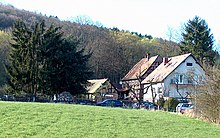Beidenau
Coordinates: 50 ° 9 ′ 31.4 ″ N , 8 ° 27 ′ 24.5 ″ E

Beidenau is a desolation of a former Hofgut in the area of the Bad Soden district Altenhain. Beidenau has been mentioned in various documents since the 12th century , but its trace is lost in the late 16th century .
location
The Beidenau estate was located in the fertile valley of the Liederbach between Schneidhain (now a district of Königstein im Taunus ) and Hornau (now part of Kelkheim ) on the eastern slope of the valley, roughly at the level of the Beidenauer Mühle (also known as the Rote Mühle ) now located there . However, the mill was only built after the decline of the estate and only adopted the field name in its name. In the 13th century , the estate had seven Hufen or 210 acres of land (equivalent to about 42.5 hectares ) and mainly operated pasture farming in the valley of the Liederbach.
history
The Beidenauer Hof was first mentioned in a document from Archbishop Konrad of Mainz from 1191, in which he guaranteed protection for the estates and dependent farms of the Retters monastery , including Beidenau. Retters had the right to graze on two meadows of the farm and charged a base rate of 5 ounces. From 1221 the seven Hufen Land in Bidinowe were under the administration of the monastery. In the 14th century , the farm was completely owned by Retters and remained there until the monastery fell in the 16th century . During this time the nuns leased the farm to different tenants. It is known from 1456 that the Junker Henne von Hornau (also known as the young hen ) ran the farm for nine years. In the period that followed, the farm changed tenants several times. When in 1535, after the death of the last Eppsteiner Count and landlord von Retters, his property passed into the possession of the Counts of Stolberg, the monastery was already in decline, due to mismanagement and debts, large parts of the property, including Wiesen in Beidenau, be sold, there was no money for urgent repairs at the Beidenauer Hof. After disputes between the monastery and the leaseholder of the court, Konrad von Hattstein , the court lord of the area, Count Ludwig from Stolberg, enfeoffed him and his heirs with the Beidenauer Hof, on condition that the farm was not fortified and that rescuers continued to have grazing rights. This expropriation exacerbated the economic hardship in Retters and ultimately led, among other causes, to the dissolution of the monastery with far-reaching consequences for the goods attached to it. The Beidenauer Hof was last mentioned in documents from the monastery from 1559. By the end of the 16th century, the courtyard was deserted and most of the buildings were demolished.
literature
- Gerd S. Bethke: Deserted towns and farms in the Main-Taunus district. In: Between Main and Taunus. Yearbook of the Main-Taunus-Kreis. Vol. 5, 1997, ISSN 0942-3419 , pp. 13-17.
- Hartmut Bock, Dietrich Kleipa, Heinz Zimmermann (Red.): Kelkheim im Taunus. Contributions to the history of its neighborhoods. Published by the Magistrate of the City of Kelkheim, Kelkheim 1980.
Web links
- Beidenau (desert), Main-Taunus-Kreis. Historical local dictionary for Hessen. In: Landesgeschichtliches Informationssystem Hessen (LAGIS).
Individual evidence and notes
- ↑ As Bidinowa . HStA Munich, Mainz certificates 33
- ↑ hsta Munich, Mainz 40 documents
- ↑ The reason for this edition was the proximity to the Count's seat, Königstein Castle . See Bock et al. (Red.): Kelkheim im Taunus. Contributions to the history of its neighborhoods. 1980, p. 71.
- ↑ Bethke: Local and court desolations in the Main-Taunus district. 1997, p. 14.
